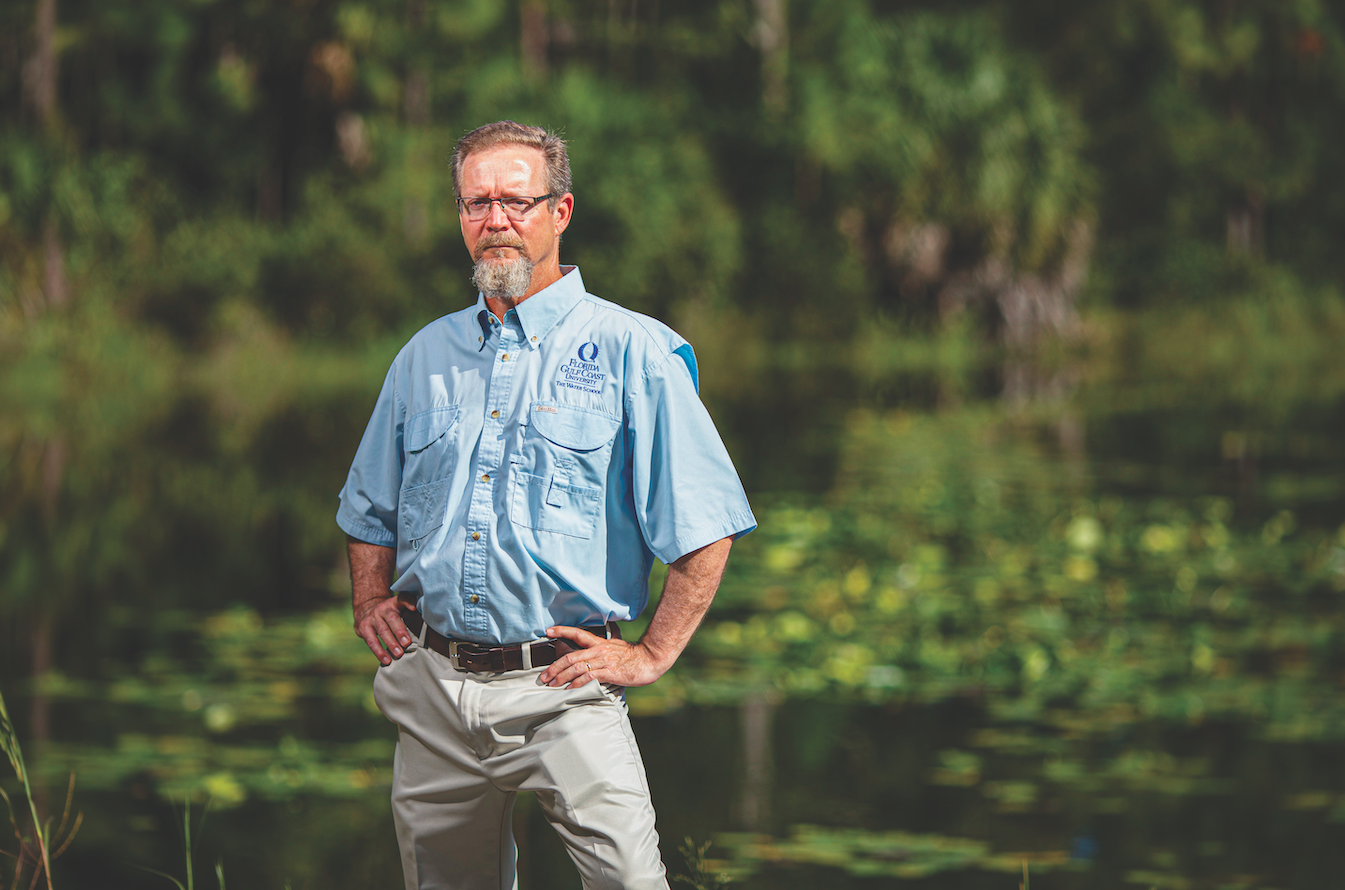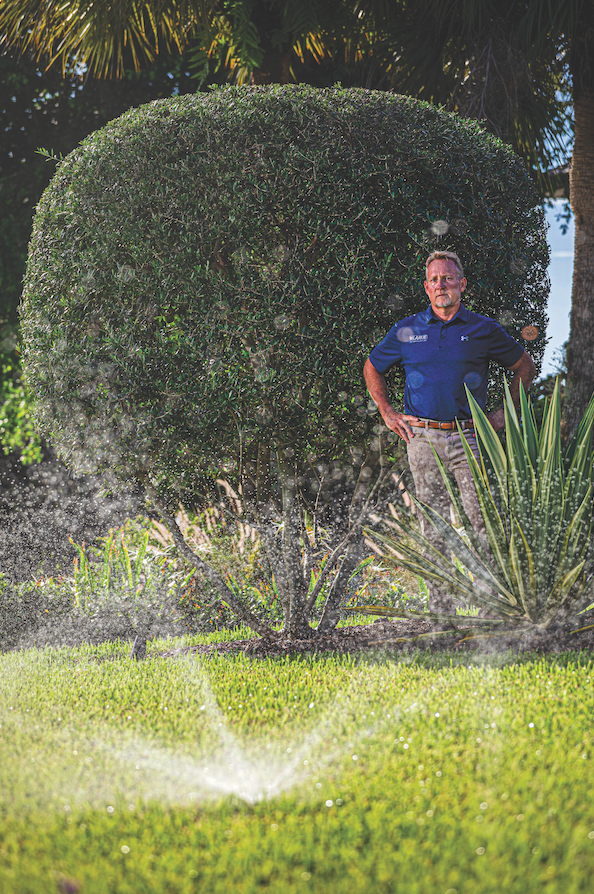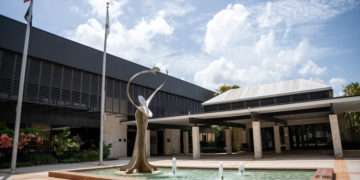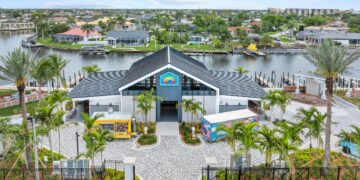In the early mornings, before the heat of the day has spread across the greens, Jason Zimmerman, director of greens and grounds at Pelican’s Nest Golf Club in Bonita his golf cart and tours the links.
He stops to examine a place that needs an extra dose of fertilizer, and takes careful notes for spoon-feeding the spot later in the day. Though golf courses are exempt from the countywide ban on fertilizer in the wet months, Zimmerman is careful to limit his usage; he doesn’t want excess nutrients making their way to local lakes and streams. He pays careful attention to the irrigation heads spread throughout the two 18-hole courses. Depending on that day’s weather predictions, he’ll draw up a plan to adjust the nozzles and the output. Water is always on Zimmerman’s mind.
In recent years, disastrous red tide outbreaks and blue-green algae blooms have brought water quality issues to the forefront for many businesses. But Southwest Florida doesn’t just face struggles with clean water. Because of our subtropical climate of alternating wet and dry seasons, this area must also navigate the challenges of not enough water. Pelican’s Nest is one of many local businesses that must balance the dual pressures of water quality and water scarcity with the demands of the area’s economy—flawless golf courses, immaculate landscaping and a pristine coastline.

Jason Zimmerman
For Zimmerman, like many golf course superintendents, striking the right balance is an exact science. “We’re not just people throwing it out there and hoping for the best,” he says. “It’s very science- and technology-based.” He points to some of the latest developments he deploys on his courses, such as sprayers for applying fertilizer that are GPS-controlled. “It will spray exactly where I want it to spray, and that way I use less product and can be more accurate.” Using less product is essential, Zimmerman knows, both for local water quality and for the private community’s bottom line. “It’s good business to be smart about water and fertilizer.”
Pelican’s Nest has 200 acres of golf course under irrigation, and the club spends more than $100,000 a year on reclaimed water. Though it has six wells on the property and is permitted to draw out 316 million gallons a year from the state’s aquifers, the water coming out of those wells—especially the deep wells—isn’t always suitable for irrigation. In Florida, a deeper well means more salt water.
Golf courses are often in the crosshairs of environmentalists when it comes to water talks, but many courses go to great lengths to balance the needs of their communities and the local ecology. Zimmerman, for example, has advanced certifications, and Pelican’s Nest is an Audubon-certified course. And although most agree that our natural resources are essential to this area’s charm, it’s hard to argue that Southwest Florida could survive without the very things many people come here for—golf, gated communities and green lawns year-round.
“Finding that appropriate balance is critically important,” says Shelton Weeks, chair of the economics and finance department at Florida Gulf Coast University. Though there’s no one right answer for achieving this balance, he is in favor of a particular solution: incentivization. “Laws and regulations tend to be marginally effective at best,” he says, pointing to the fertilizer ban across Southwest Florida in the summer months. “How do we enforce that? There’s really almost no way.”

Shelton Weeks
Instead of fighting offenders, Weeks suggests that governments incentivize good behavior, along the lines of a tax credit for businesses that swap out lush landscaping for water-friendly xeriscapes. “Water troubles have a ripple effect into the economy of Southwest Florida,” he says.
Keith Ruebeling, president of Larue Pest Management in Fort Myers, understands firsthand the complex balance local businesses face. Larue offers lawn, landscape and irrigation services in addition to pest management. When Lee County’s summertime fertilizer ban first went into effect 12 years ago, Larue’s expenses doubled overnight. “It was a big strain on the business from a cost standpoint,” he says, referring to the switch to slow-release fertilizer, which could be applied before the summertime blackout dates. “But we were able to pivot to keep our costs in line, and that’s leveled out over time.”
Ruebeling runs his business with an eye on controlling nutrients and limiting water consumption. “For nutrients, the key is proper application,” Ruebeling says. “As a business owner, my objective is to use as little product as we can, for obvious cost reasons.” And for water conservation? Like Zimmerman, Ruebeling points to the use of technology—weather stations that can predict rainfall, sensors that shut off irrigation after a downpour and soil probes that check for moisture content in the ground. “It goes back to best management practices,” he says. “And a responsibility factor. Everybody has to work together to minimize the amount of water used.”
Ruebeling is a sixth-generation Floridian, and he knows that water quality is essential to this area, and that water scarcity weighs heavily on its residents. Like many local business owners, he recognizes the complicated tension that exists between the needs of Southwest Florida’s water resources and the demands of our economy. “Water is always going to be an issue for us,” he says. “It comes down to how we manage it.”

Keith Ruebeling
NO FERTILIZER, NO PROBLEM
Lee County has had a summertime ban on fertilizer since 2008. The reason? Source control. In the early aughts, a group of federal, state and local agencies set out to determine how best to improve water quality. What they learned was that it’s more cost-effective to control the source of excess nutrients than to try to remove them once they’re already in local waterways.
“It’s pay me now or pay me later,” says Kurt Harclerode, operations manager with the natural resources division of Lee County government. “We can spend millions of dollars on designing and building water quality projects that will take nutrients out of the water, or we can keep the nutrients out of the water in the first place—which doesn’t cost much at all.”
The fertilizer ban extends through the rainy season, from June 1 to Sept. 30, in an effort to keep runoff from washing into lakes, streams and waterways. But this doesn’t mean disaster for lawns and landscaping, Harclerode said. There are good slow-release fertilizers on the market, so it’s possible to get nitrogen and phosphorous into the ground before the rainy season starts. And soil amendments such as compost and wood ash can help green spaces stay lush.
Lee County isn’t investing a lot of time or resources in tracking down those who break the fertilizer ban. Instead, they’ve put their money into education. In addition to local publicity campaigns, they’ve launched a certification program that teaches clean water best practices. For businesses in the market for a lawn and landscape company, Harclerode said it’s important to make sure that the company has received this certification.
Of course, there are a number of variables to water quality, and many of the nutrients in local waterways come from outside this area. Still, the summer fertilizer ban and similar efforts help contribute to a solution. “We know less nutrients going into our waterways is certainly going to be an improvement,” Harclerode says. “We don’t need a lot of empirical data to tell us that.”

MANAGING SCARCITY IS GOOD FOR THE BOTTOM LINE
When it comes to rain, it’s feast or famine in Southwest Florida, said Tom Becker, a horticultural agent with the University of Florida’s Cooperative Extension Service in Collier County. With an average monthly rainfall of 9.3 inches in the wet season and only 2.3 inches during the eight months of the dry season, water management can be a tricky business.
“I was shocked to see how much water was being used outdoors to sustain green lawns,” says Becker, who moved to Cape Coral from Pennsylvania in 2003. Between sandy soil that doesn’t hold moisture and high temperatures that contribute to rapid evaporation, it seemed to Becker that water was always disappearing.
For businesses with big water expenditures, Becker recommends smart irrigation technology. This includes advanced irrigation controllers, soil moisture sensors and micro-irrigation and drip systems that deliver water directly to roots— tools that can dramatically cut down on water usage. Though these devices come with a higher price tag, Becker suggests that the long- term returns justify the investment, especially in gated communities where the costs can be shared.
And for those who can’t afford to put cash into better irrigation, he has a less-capital-intensive solution—native plants. His favorites? Simpson’s stopper, muhly grass, American beautyberry, coontie and firebush. “These are very drought tolerant and have very little water demand once they’re established,” he says. “We’ll need to keep thinking along those lines if we’re going to protect our water resources.”





